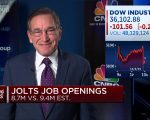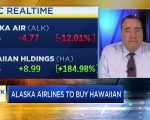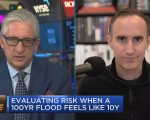A help wanted sign on a storefront in Ocean City, New Jersey, US, on Friday, Aug. 18, 2023. Surveys suggest that despite cooling inflation and jobs gains, Americans remain deeply skeptical of the president’s handling of the post-pandemic economy. Photographer: Al Drago/Bloomberg via Getty Images
Al Drago | Bloomberg | Getty Images
Inflation is “always going to be a risk” in the U.S. due to structural changes in the labor market, according to Nela Richardson, chief economist at payroll processing firm ADP.
Last year, with inflation spiraling out of control across major economies in the aftermath of the Covid-19 pandemic, the U.S. Federal Reserve began a run of interest rates hikes that would take the Fed funds rate target range from 0.25-0.5% in March 2022 to a 22-year high of 5.25-5.5% in July 2023.
Prior to that, interest rates had remained low for a decade as central banks around the world looked to stimulate their respective economies in the wake of the global financial crisis.
Speaking to CNBC’s “Squawk Box Europe” on Friday, Richardson said the past 10 years of U.S. economic growth had been driven by low interest rates as policymakers focused on negating recession in the absence of inflationary pressures.
“This was an economy built on very close to zero interest rates for 10 years of economic expansion, and that was OK because inflation was super low,” she said.

“But now inflation has awakened, and if you look at demographic trends, labor shortages are not going away. It’s getting better but that’s a structural change in the labor market because of the aging of the U.S. population, so what that means is inflation is always going to be a risk, it’s going to prop up, and so going back to zero or near rock bottom interest rates is going to be difficult to support the economy.”
Richardson added that the “training wheels have come off” the U.S. economy and that both businesses and consumers are now having to “ride a regular bike.”
Despite fears of a recession on the back of the Fed’s extraordinary run of monetary policy tightening, the U.S. economy has remained surprisingly robust. The rate-setting Federal Open Market Committee paused its hiking cycle in September and sharply increased its economic growth projections, now forecasting 2.1% growth in GDP this year.
Meanwhile, inflation is coming back toward the Fed’s 2% target and the labor market tightness that some economists feared was adding to inflationary pressures has shown signs of abating, though unemployment still remains relatively low by historic comparisons.
ADP’s monthly report on Wednesday showed that private payrolls rose by just 89,000 in September, well below a Dow Jones consensus estimate of 160,000 and down from an upwardly revised 180,000 in August.

This offered a contrasting signal to a Labor Department report earlier in the week in which job openings posted a surprising jump in August, rising to their highest level since the spring and reversing a recent trend of declines.
Markets, and Fed policymakers, will be closely watching Friday’s nonfarm payrolls report for further indications as to the health of the U.S. labor market.
Though jobs reports have been traditionally viewed as a lagging indicator, Richardson noted that the relationship between the labor market and monetary policy has been overhauled in the course of the current cycle.
“I think there is a feedback loop that is underappreciated. People say the labor market or a good jobs picture is lagging, but the jobs picture is actually feeding current Federal Reserve policy, so it’s not just going in just one direction, there’s a feedback loop in between and these effects can amplify,” she explained.
“A simple relationship no longer exists. We are in a complex period of the global economy, not just the U.S., and the actions taken by the Fed affect the labor market but vice versa. So we can’t just say ‘oh this is lagging, six to nine months of Fed policy is going to show up in the labor market’ — the labor market is driving Fed policy now.”







